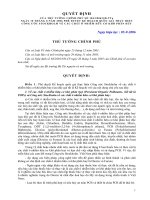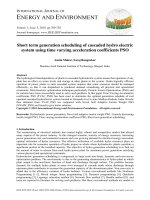bergey stockholm short
Bạn đang xem bản rút gọn của tài liệu. Xem và tải ngay bản đầy đủ của tài liệu tại đây (604.55 KB, 21 trang )
Toward a Model for Generational
Transition of Sustainable Energy
Platforms:
The Greenfield vs. Brownfield Problem
Paul K. Bergey
North Carolina State University, USA
&
Geoffrey G. Parker
Tulane University, USA
2
“Our goal is to build a
supply chain from
lignocellulose to
butanol.”
Tony Hayward, (former) CEO of BP
A Dark Cloud Appears over Ethanol
•
In 2008, there were 170 ethanol plants operating
in the U.S. and 24 additional plants under
construction to provide a total production
capacity of approximately 12.6 billion gallons per
year
•
In 2009, the Renewable Fuels Association
reported that 24 plants with a combined capacity
of over 2 billion gallons per year are currently not
producing and about 12 were in bankruptcy.
It Has a Silver (Biobutanol) Lining
•
It has a higher energy density per unit volume
than ethanol.
•
It is compatible with the existing distribution
infrastructure for petroleum based fuels, and
thus, can be distributed via the national pipeline
network, unlike ethanol.
•
It is highly resistant to moisture absorption and
therefore has potential as an aviation fuel
•
It can be burned in existing automobile engines
in any blended proportion (up to 100%)
•
It is cleaner burning than gasoline or ethanol
Butamax Advanced Biofuels LLC
•
“Fuel and fleet testing of biobutanol in real
vehicles on real roads – covering a distance of
more than 1.3 million vehicle road-miles – has
confirmed the high performance advantages of
this fuel blend. For example, biobutanol blended
at a concentration of 16%* volume into fuels
demonstrated excellent vehicle performance. A
commercial fuels trial confirmed the
compatibility of butanol with existing fuel
infrastructure and consumer satisfaction with the
product.”
The Greenfield vs. Brownfield Problem
Coalition Definitions
Necessary Conditions for a Non-Empty
Core in a 3 Player Game
Characteristic Functions – 3 Players
Three Player Game Solution Plane
The Core is Defined by an Irreducible
and Consistent System of Constraints
Two Necessary and Sufficient
Conditions for a Non-Empty Core to a
3 player Greenfield vs. Brownfield
Game
Exploring Equilibria in the DV space
Exploring Equilibria in the DV space
Exploring Equilibria in the DV space
Exploring Equilibria in the DV space
Conclusions
•
The reduced set of sufficiency conditions expose tipping points
which yield managerial insights through sensitivity analysis of the
core
•
Brownfield conversions only make economic sense when the
destruction of a productive economic asset is justified by the
avoided cost of an economically equivalent greenfield option
•
Early opportunities arise for brownfield conversions of lower
producing high margin plants (particularly those of limited size and
opportunistic location)
•
The social benefit of the 2
nd
generation biofuel plant “should”
exceed the social benefit of the 1
st
generation plant to achieve
sustainability of the core
•
Higher levels of 2
nd
generation biofuel production combined with
higher levels of social benefit on a per unit basis of 2
nd
generation
biofuel suggest a stable brownfield grand coalition
Butanol Physical & Fuel Properties
18
Physical Property i-butanol n-butanol Ethanol
Density at 20°C (g/cm³) 0.802 0.810 0.794
Boiling Point at 1 atm (⁰C) 108 118 78
Water Solubility at 20⁰C (g/100mL
water)
8.0 7.7 Miscible
Net Heat of Combustion (BTU/gal) 95,000 93,000 80,000
R+M/2 103.5 87 112
Blend RVP (psi at 100 F)⁰
1
5.0 4.3 18-22
Promotum, Gevo
19
Bio-Butanol Projecting the 3
rd
Wave
20
Status Domestic Butanol Companies
Company Bug Bug
Strategy
Molecule Fermentation
Process
Separation
Strategy
Development
Status
Gevo Yeast GMO UCLA
Valine
metabolism
iso-buoh Semi batch vacuum flash in situ
removal followed by
distillation trains
2010 Operating pilot in
St. Johns, MO. 2011
Commercial
Cobalt Biofuels Clostridium Non GMO
strain reduced
etoh and
acetone
n-buoh for
blending
w/gasoline,
diesel, jet
Continuous modified
ABE Fermentation
vapor compression
distillation
2010 pilot 10-35k gpy
2011 demo 2-5m gpy
2012 commercial
Tetra Vitae Clostridium
beijerinckii
Non GMO
selected for
reduced etoh
production
n-buoh and
acetone 2:1
Semi batch "AB"
Fermentation
Carbon dioxide
stripping continuous
in situ removal
followed by
distillation trains
2009 300 liter bench
2010 10,000 liter pilot
Butyl Fuel Clostridiums
Aceto & tyro
GMO & mutant
strain
n-buoh Continuous two stage
dual path anaerobic
fermentation
stripping following
immobilized cell
bioreactors
Unknown
Syngas Biofuels
Energy
Fermentation of
Syngas
GMO n-buoh Thermochemical
catalyst
NA Unknown
21
Status International Butanol Companies
Company Bug Bug
Strategy
Molecule Fermentation
Process
Separation
Strategy
Development
Status
Butamax
(DuPont/BP)
1.Clostridium
2.E.Coli
GMOs iso-buoh Semi batch continuous in situ
removal followed by
distillation trains
2010 Salt End Hull, UK
2013 Commercial
Additional Feedstocks
2013+
Green
Biologics (UK)
Clostridium.
Mixed
populations
GMOs high
tolerance (4%)
n-buoh Continuous
fermentation
In situ removal
unknown.
Building demo in India.
Consulting w/Chinese
firms
Metex (FR) "Well known
bacteria“
GMOs n-buoh Unkown In situ removal
unknown.
Unknown
Butalco
(Switzerland)
Yeast GMOs unclear Unkown In situ removal
unknown.
Unknown
China Clostridium Currently
selected
strain.
Migrating to
GMOs
n-buoh Migrating from
traditional ABE
Fermentation.
May include in situ
removal
2010 100MM gpy
traditional ABE. 201X
migration beyond ABE.
Plans to add 350 MM
gpy new capacity.









